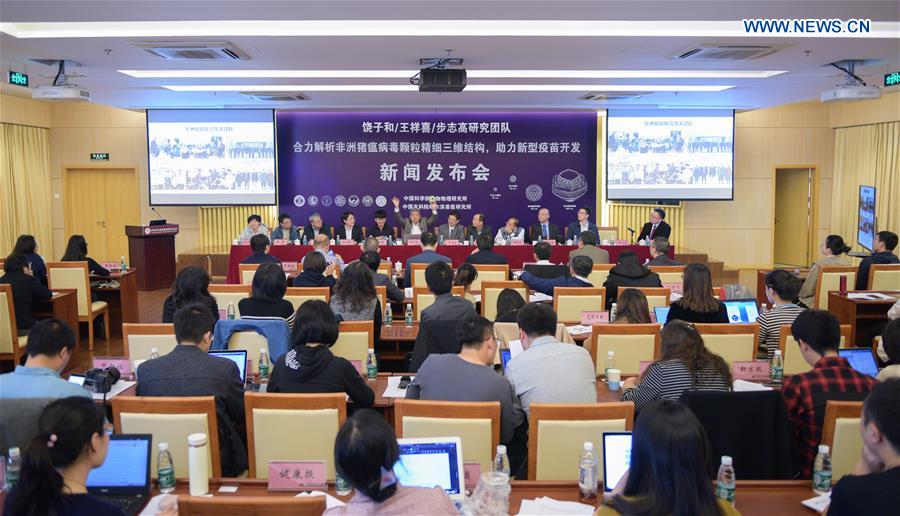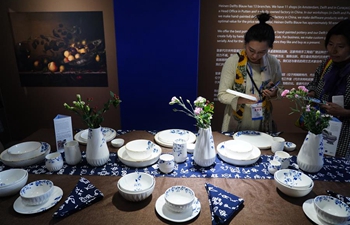
Rao Zihe (6th L), an academician with the Chinese Academy of Sciences (CAS), briefs the media about the breakthrough made in researching African swine fever virus at a press conference held by the Institute of Biophysics of CAS in Beijing, capital of China, Oct. 18, 2019. Chinese scientists have unraveled the three-dimensional structure of the African swine fever virus, laying a solid foundation for developing effective and safe vaccines against the disease. The research, jointly conducted by scientists at the Institute of Biophysics of the Chinese Academy of Sciences (CAS) and the Harbin Veterinary Research Institute of the Chinese Academy of Agricultural Sciences (CAAS), ShanghaiTech University and other institutes, was published in the latest issue of the academic journal Science. (Photo by Wang Qiang/Xinhua)
BEIJING, Oct. 18 (Xinhua) -- Chinese scientists have unraveled the three-dimensional structure of the African swine fever virus, laying a solid foundation for developing effective and safe vaccines against the disease.
The research, jointly conducted by scientists at the Institute of Biophysics of the Chinese Academy of Sciences (CAS) and the Harbin Veterinary Research Institute of the Chinese Academy of Agricultural Sciences (CAAS), ShanghaiTech University and other institutes, was published in the latest issue of the academic journal Science.
Bu Zhigao, director of the Harbin Veterinary Research Institute of CAAS, said China is facing a great challenge in controlling the spread of African swine fever. It is urgent to develop a more powerful technology tool including a vaccine to prevent the disease.
"The new breakthrough in unveiling the fine structure of the virus is important fundamental research, which will provide clues to explore fundamental mechanisms for infection, pathogenicity and immunology of African swine fever, as well as vaccine development," Bu said.
Scientists successfully isolated the epidemic strain of the African swine fever virus, which is spreading in China. It took the research team four months to collect over 100 TB of high-quality data.
The research showed the virus has a unique structure of five layers: the outer membrane, capsid, double-layer inner membrane, core-shell and genome.
It contains more than 30,000 protein subunits, forming a spherical particle with a diameter of about 260 nanometers.
The study identified structural proteins of the virus, revealing potential protective antigens and key information on the epitope, the part of an antigen molecule to which an antibody attaches itself.
The research also showed the complex arrangement and interaction mode of the structural proteins and proposed the possible assembly mechanism of the virus, providing an important clue as to how it invades host cells and evades and antagonizes the host antiviral immunity.
Wang Xiangxi, a researcher at the Institute of Biophysics of CAS, said the five-layer structure of the African swine fever virus is very rare and complicated compared with other viruses.
"The size of the African swine fever virus is huge, which is the largest one among the viruses unraveled by Chinese scientists. Its diameter is ten times longer than the diameter of the hepatitis A virus," Wang said. "African swine fever, with an epidemic history of nearly 100 years, is a challenging global problem. It has a stable structure and can survive for months under normal temperatures, posing a great challenge for prevention and control. Scientists have limited knowledge of the virus. We hope to open the door to have a better understanding of the disease."
Rao Zihe, a CAS academician and one of the leading scientists of the research, said unveiling the structure of African swine fever is the first important step in the "long march" to tackle the disease. Researchers will continue to analyze the structure of the virus's core-shell, and how the virus interacts with the receptors.
Shao Feng, another CAS academician and deputy director of the National Institute of Biological Sciences, said compared with other viruses, scientists' knowledge about African swine fever is almost zero. Cooperation between scientists including immunologists is needed to push forward vaccine research.
African swine fever is believed to only infect pigs. No humans or other species are known to have been infected.
China reported its first case of the disease in August 2018 in the northeastern province of Liaoning. Later outbreaks were reported in other provincial regions.
China has the largest pig-producing quantity in the world, and it is an arduous task to control African swine fever. China has conducted lab research on the vaccine against the disease, but the vaccines under development are still not perfect, according to Bu.
Previous developments of the vaccines used traditional methods, lacking clear theoretical guidance. Recent research may prove beneficial for new designs of the vaccines, Bu said.















